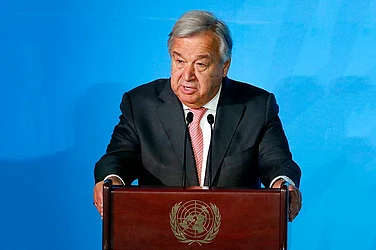If you are a woman in India, on average, you will earn 27 per cent less than what men earn for doing the same job. This holds true for women across the world as well. Men still earn more than women in most countries in nearly all industries due to persistent gender segregation, among other factors.
When Canadian Prime Minister Justin Trudeau was asked eight years ago why achieving gender parity was important in the Cabinet he had formed, he responded, “Because it’s 2015.” We are two months away from 2024, but gender parity still remains elusive across the world.
According to a report by the International Labour Organisation (ILO), there are still many people who believe it is unacceptable for a woman to have a paid job outside the home: 20 per cent of men and 14 per cent of women globally to be precise. Many women reported that their immediate family disapproved of their decisions to work outside the home. Due to this, coupled with unfair pay practices, gender discrimination, and uneven sharing of family and caregiver responsibilities, women tend to earn less than men for performing the same tasks.
Such gender disparity also exists in the most ‘gender-neutral’ country. Iceland has topped the World Economic Forum’s (WEF) Gender Report rankings for 14 years in a row. But tens of thousands of the country’s women and non-binary persons lament that the demand for women’s work to be valued at the same level as men remains unmet for 48 years. It was 48 years ago that 90 per cent of Icelandic women refused to work as part of “kvennafrí” (women’s day off) which culminated in a pivotal moment with the election of the world’s first female president of a country.
Women from this so-called ‘equality paradise’ brought the nation to a standstill last week, demanding their fair share of pay.
Gender parity across the world
Similar stories emerge from women in other corners of the world. India ranks a low 108th out of 153 countries in terms of the gender pay gap, with women earning just 71 per cent of what men earn, according to a report by the World Economic Forum (WEF). This gap is particularly wider in certain industries, such as the technology sector, where women earn just 60 per cent of what men earn despite the fact that women make up nearly 30 per cent of the Indian technology workforce.
Despite some progress in closing the gender pay gap in India, the numbers are still abysmal as per international standards. As per the labour force survey data of the National Sample Survey Office (NSSO), Indian women on average earned 48 per cent less than their male counterparts in 1993-94. Since then, the gap has declined to 28 per cent in 2018-19.
Although no country has yet achieved full gender parity, the top nine countries —Iceland, Norway, Finland, New Zealand, Sweden, Germany, Nicaragua, Namibia, Lithuania— have closed at least 80 per cent of their gap, according to WEF.
Norway ranks second in the WEF’s 2023 rankings with a global gender gap estimated to be 87.9 per cent closed. It also ranked first in the 2021 Women’s Peace and Security Index.
New Zealand comes in fourth on the WEF report overall, making it the top performer in the Southern Hemisphere. Around 50 per cent of its parliament members are female, while female enrolment in primary and secondary education is nearly on par with males.
The gender gap of Namibia, the only African country in the top 10, is estimated to be 80.2 per cent closed, ranked at eighth position – surpassing leading countries in other parts of the world, including the United Kingdom (15th), Spain (18th), Canada (30th), and the United States (43rd).
Top rank doesn’t translate into gender equality
But the rosy picture painted by the report depends on what parameters are being looked at. While Iceland ranks first in political women empowerment, it ranks 79th in educational attainment and 128th for female health and survival.
New Zealand too is far from perfect. The WEF found that women earn on average $33,620 per year compared to $52,370 for men. It ranks 37th in terms of wage equality for equal work. It also performed relatively poorly on female life expectancy and ranked at 109th in the report.
The Philippines too is ranked 16th in the report. However, the gap widened in the share of parliamentarians who are women (37.6 per cent parity), thus “effectively decreasing overall parity on the political empowerment subindex (40.9 per cent) by 0.7 percentage points since 2018”, the WEF noted.
The Philippines achieved full parity in terms of how many men and women were employed as senior officers and technical workers, but the pay gap remains as women’s income is just 71.6 per cent of that of men, as per the report.
The wait will continue. Women worldwide may have to wait for another 131 years to achieve gender parity with men, the WEF noted.
India in September passed the long-standing Women’s Reservation Bill, which reserves one-third of all seats for women in the Lok Sabha and legislative assemblies. But the fact that the much-needed legislation is tied to the passing of another exercise —related to delimitation exercise and census— which has been inevitably delayed for years and might not be dealt with until the Lok Sabha elections of 2029 show that the dream of gender parity remains distant. Not just in India, but also in the ‘equality paradise’.


























